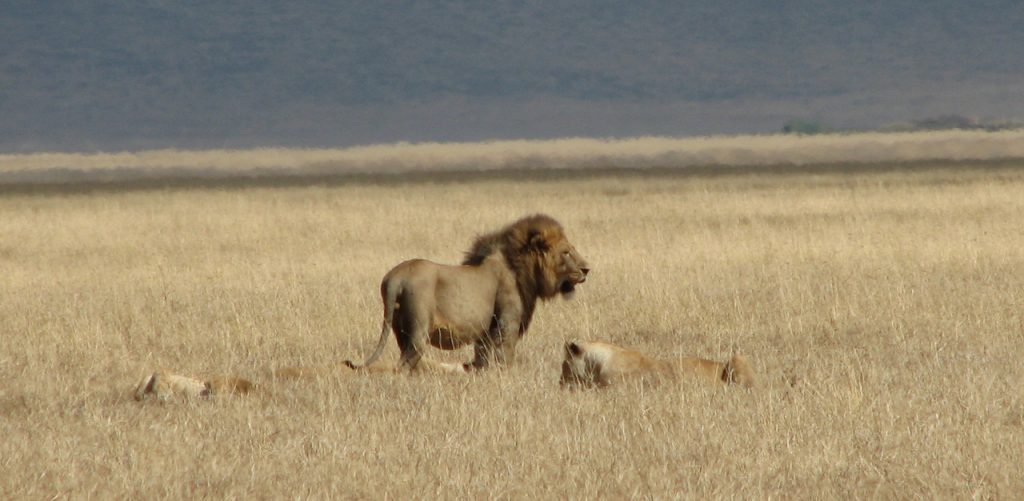Ngorongoro Conservation Area
The Ngorongoro Conservation Area
The Ngorongoro Conservation Area is known to be the largest area that was established as a separate conservation area in the 1959, the area covers 8400 square kilometres and it includes the volcanic highlands. The Ngorongoro stretches from Lake Manyara in the east, lake Natron in the north and Lake Eyasi in the south. This area also includes four main features i.e the crater, lakes and the mountain
The crater: Ngorongoro crater, Empakai Crater and the Olmoti
The Lake: Lake Natron, and Lake Magadi Soda
The mountain: Oldonyo Lengai which is still active and this is where Dr. Leakey discovered the human skull.
The Ngorongoro Crater, Tanzania
This is one of the largest unbroken caldera in the whole world with an area of 260 square kilometres. This crater measures 20 kilometres in diameter and sometimes has the impression that from the crater rim, the animals are within touching distances. This crater floor is full of the big and small wild animals that are resident mammals. The crater has got a very beautiful view and the fascinating concentration of the resident mammals as well as the bird life in the highland forest that makes it to be named the 8th Natural Wonder of the world that was formed after a massive volcanic eruption.
This crater can be visited at any time of the year, but the best season is in July to October and in December to March. The crater can be reached by 4×4 vehicle and the road from Arusha to the Oduvare gate is tarmacked and covers about 90 km via the Mto Wa Mbu and the Karatu Village.
The Ngorongoro Crater is also called the Africa’s Eden and the 8th National Wonder of the World, A visit to this crater is the main draw card for the many tourists that come to Tanzania and it’s a world class attraction. Inside the crater rim, there is the large herd of zebras and the wildebeests grazing nearby as the lion enjoy the sun.
Ngorongoro Crater is 8, 3000 sq km in size and its located within the Ngorongoro Conservation Area at the eastern edge of the Serengeti, Getting to the crater requires a drive from Arusha , lake Manyara and Tarangire national park. There are many things that can be done with in this area including; vehicle safaris to the Ngorongoro crater, hiking treks, olduvai Gorge, bird watching and many more. It’s also advisable visit the crater in the months of December to July and in June to October in order to follow the wildebeest Migration as well as seeing the predators. This national park has also got two luxury lodges.
The Ngorongoro crater is known as a sunken volcano or the largest intact volcanic caldera. Its crest will provide you with an expansive sight of the entire crater that covers an area of 260 square kilometres. There is also a relationship between the Ngorongoro eco system and the maasai tribe since the maasai people herd their own cattle into and out of the crater for water which leads their cattle to water alongside the big five. This crater is small and one can visit the floor of this crater at any time. The crater is located in the northern circuit which is 4 hours outside Arusha on the way to Serengeti. There are many activities that can be done in the crater including; the Game drives, visit to the Maasai Boma, hiking, nature walks and a visit to the Olduvai Gorge. One and half day is usually enough to see the crater and the Ngorongoro Conservation Authority limits the game drives to half days. The animals found in this area include; lions, leopards, buffalos, Elephants, Zebras, Giraffes, Warthogs, Hippos, hyenas, wildebeest and the Ostrich. Perfect destination for a first time wildlife Safari in Tanzania or once in a lifetime Tanzania Safari tour.
 The Ngorongoro Conservation Area at large.
The Ngorongoro Conservation Area at large.
This Ngorongoro Conservation Area covers an area of 8,288kms. The Ngorongoro Conservation Area harbours the Ngorongoro crater and the panorama spreads out in the vast arena. The hills rise smoothly from the crater floor through the evergreen forest, and the rain clouds run over the eastern rim. The wildebeests and the zebras mix on the crater floor along with 400 spotted hyenas, 50 lions, grant and Thomson gazelles, jackals as well as the flamingos. Ngorongoro has over 25000 animals, which makes it the most intensive game viewing area on earth.
The Olduvai Gorge & Laetoli Footprints
The olduvai Gorge is located on the Serengeti’s eastern plains and its physically in the Ngorongoro Conservation Area. This site is strangely as it benefits its ancient status. In 1959, Maty Leakey uncovered the skull of the zinjanthropus boisei or the famous Nutcracker man. The first European to first have seen the gorge was a German butterfly collector, Professor Wilhelm Kattwinkle. This professor in his book described the Olduvai Gorge as “the book of life” there are also the 25 miles to the southwest of the olduvai, which are over 3.6 million years old laetoli footprints, which are the earliest of the forbears that are known to have been left.
The Flora in this area includes; the lakes, swamps, grasslands, heath, dense mountain Forest and many more. The wildlife here includes; zebras, wildebeests, gazelles, Rhinos, hartebeest, hippos, buffalos, elephants, leopards, serval, kiri bastard, ostrich, and the papilio sjoestedti
The Overview of Ngorongoro crater
The Ngorongoro crater is known as the world heritage site and it’s the largest intact volcanic caldera referred to as the 8th wonder of the world. Its wall is 2000 feet and its 10 miles wide to create a natural amphitheatre for the densest populations of the large animals anywhere. You will also have a chance to view the big carnivores.
This crater also lives up to its infamous reputation with variety of wildlife and also offers a chance to see the lions, hyenas, and the cheetah. This carter is so inspiring and will surely be one of the best highlight of the safari. The rim of the ngorongoro crater ranges in an altitude from 7000 to 8000 feet.
About the Ngorongoro Crater Wildlife Summary
This crater is rich with soils and abundant water throughout the year, this water provides an ideal habitat for the many animals. The crater is also not a self-contained ecosystem and some of the animals here do migrate in and out but in small numbers. Most of the animals here are residents and remain year round. There are over 20000 large mammals with in the crater walls.
The herbivores you will meet include; the elephants, hippos, Rhinos, eland, wildebeests, zebras, waterbuck, hartebeest, grant’s gazelles and the Thomson Gazelles, and hartebeests, giraffes, impalas, topis are all found in the crater floor. The giraffes might find the crater difficult to live in due to the absence of the acacia to browse. The primates found here include the vervet monkeys and the baboons. The carnivores to be met here include; the lions, cheetahs, hyenas, jackals, leopards, ratels and the servals.
The Ngorongoro Crater Floor
The Ngorongoro crater floor is also called the microcosm of the Serengeti because there are mainly four habitats located in the small area of the crater floor that reflect the major habitats of its enormous neighbour, the Serengeti ecosystem; these habitants include the following;
The Lerai forest which is located in the south-western side of the crater, the lerai is a maasai word meaning to the tall yellow barked acacias that dominate the forest. This forest is so beautiful and is also home to many animals including the baboons, vervet Monkeys, bush buck and the water buck. The forest is well known for its small population of the giant tusker bull elephant and it’s also home to the only leopards in the crater. These leopards are spotted on occasions but remain very much elusive. The tourists are advised to visit the forest during morning hours.
The Central- western area has got Lake Magadi which is known as Lake Makat and plays host to many of the migratory Flamingos. This lake is full of water or the dry expanse of the white soda which depends of the season. Both the north-western and the south eastern regions of the crater are home to the two large seasonal swamps. These area are also good for hippos and many other water birds.
As you spread throughout the central area of the crater floor, is the short grass plains that are home to thousands of the zebras, wildebeests, Thomson’s gazelles. And in the eastern section of the crater, there are the longer grasses where many of the buffalos roam. There is also one of the smallest carnivores the serval cat which is found here in the tall grass.
The Crater’s Elephants
These elephants in the Ngorongoro are so impressive and are the largest that you will encounter while on your safari. The elephants are predominantly old bulls that flaunt the giant ivory tusks. These also survive the pre ivory ban days in the 1980s when many they were poached. There are also no breeding herds with in the crater and there are no females known to live in the crater floor. The best place to view these elephants is in Lerai Forest.
The Ngorongoro Crater’s Black Rhinos.
The black Rhinos are also highly endangered and these have been poached too much. The Ngorongoro crater is the last place in Tanzania where the black Rhinos can be seen. in 1965, there were only 100 Rhinos in the crater , by 1980, poaching had reduced this population of Rhinos. These endangered species are now under a 24 hour ranger watch and since then, numbers have been increasing.by 2004, the numbers of Rhinos was 17. You can also spot the Rhinos in the Moru Kopjes.
The Black Rhinos are also seen in the east of the Lerai Forest, in the area between Lerai and Gorigor swamp. It’s more likely that you will one on any single game drive, the best way to track down the Rhinos is with the early morning game drive, once you are down on the floor in the morning, go to the Lerai forest to its eastern outskirts. These Rhinos spend the night in the Lerai forest and move to the eastern part of the forest in the Morning.
The Carnivores in the Ngorongoro Crater
The crater is the second best place in Tanzania to view the large carnivores. Serengeti is also better for the large carnivores and nothing can beat the Serengeti’s lions, cheetahs, ratel, serval, Jackal, and the bat eared Fox. In 2004, they were over 25-30 lions, 50-60 hyenas, 10-12 cheetahs living in the Ngorongoro Crater. There are also four prides of lions and six clans of hyenas found in the crater floor. Most of our safari tours in Tanzania include the Ngorongoro Crater and one that tour is the 3 days Ngorongoro Crater Trekking tour.
The Recommendations
The Ngorongoro crater, is described as one of the wonders of the world and is an amazing natural place not to be missed. Game viewing is best carried out in this place and it’s offered throughout the year. This crater is small at only 10 miles across, with only one game drive, you can easily spot all the animals with in the crater. Every safari offered by Go Tanzania safaris has got two game drives, that’s to say the morning and evening game drives. The main goal for the morning game drive is to be the first person in the crater and the animals are so active in the morning hours which makes the morning game drive an excellent option.




